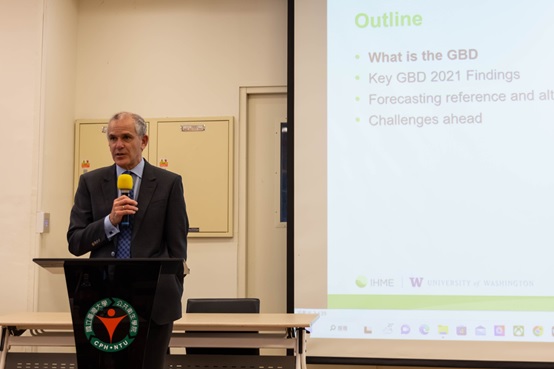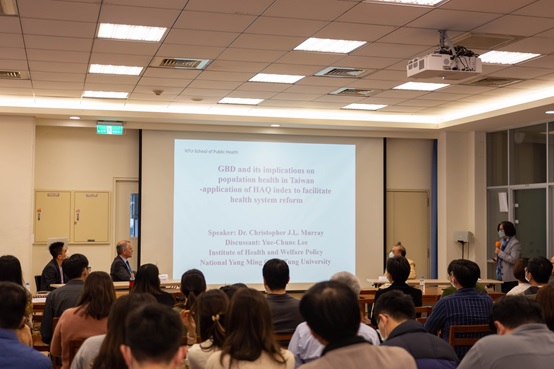
Where are we headed: Insights from the GBD
Editors: Taiwan Burden of Disease Center Bing-Huan Tsai, Yi-Hsuan Lo, April Hill; Proofreader: Fang-Wen Lu; Photographer: Wan-Tzu Hsia
On January 10, 2023, the College of Public Health at National Taiwan University and Taiwan Burden of Disease Center jointly hosted the “Where are we headed: Insights from the GBD” forum. We invited the Director of the Institute for Health Metrics and Evaluation (IHME), Professor Christopher J.L. Murray from the University of Washington, as our distinguished speaker. IHME is an independent health research center within the College of Medicine at the University of Washington. Since 2012, it has published the results of the Global Burden of Disease Study (GBD), which estimates the disease burden caused by various diseases and risk factors in countries across the globe. The goal of the GBD is to synthesize global health evidence and provide governments with empirical data for formulating policies related to health promotion and disease prevention.
To begin the session, Professor Murray presented a brief introduction of the core GBD principles and structures. The GBD utilizes comparable models to calculate the best estimates of disease burden, measuring multiple metrics of morbidity including disability-adjusted life years (DALYs) and health-adjusted life expectancy (HALE) while ensuring validity and internal consistency. In addition, the open-access data platform, Global Health Data Exchange (GHDx), has played a key role in promoting data sharing, particularly of recent work in the field of disease burden estimation.
The GBD 2021 report, which is expected to be released later this year, includes a total of 1075 locations, 376 disease causes, 88 risk factors, and 25 age groups. When analyzing the tree map of attributable DALYs within GBD 2021, it is evident that the disease burden directly attributable to COVID-19, an emerging infectious disease, has surged dramatically. On the other hand, certain facets of COVID-19-related disease burden could not be clearly attributed, so they remained uncategorized and independent from the original disease classification. One notable change in the DALYs tree map in 2021 is that the proportion dedicated to many types of cancer has shrunk. In 2021, global DALYs were mostly attributable to risk factors including air pollution, malnutrition, high blood glucose, and high body mass index (BMI). In relation to communicable diseases, GBD 2021 is the first time that DALYs and mortality resulting from antimicrobial resistance (AMR) were calculated, and it was surprising to see that nearly 5 million people died of antimicrobial drug-resistant diseases. The study also reveals that 26% of global DALYs are associated with pathogens, with AIDS (human immunodeficiency virus), tuberculosis (Mycobacterium tuberculosis), and malaria (Plasmodium spp.) responsible for the three largest shares.
The talk then shifted to disease burden distributions in Taiwan. In regard to communicable diseases, the burden due to lower respiratory infections (LRIs) has increased. For non-communicable diseases, ischemic heart disease (IHD) and stroke have declined in proportion. Cancer and diabetes-related DALYs remain among the top-ranking diseases, even demonstrating an increasing trend. Although both Taiwan’s average life expectancy and HALE continue to increase, the rate is much slower in recent years than in years past.
GBD 2021 also establishes a more comprehensive forecasting system, which comprises risk exposure factors and socio-economic drivers used to project future disease burden trends, acquire results under various alternative scenarios, and even respond to public policy-relevant questions. The GBD forecasting models predict that the global population will peak in the year 2058, and the resulting inverted population pyramid will bring about profound fiscal and health systems impacts for society. Climate change may also have complicated interactions with health risk factors, while emerging infectious diseases and war are both health issues that require global attention and international cooperation. Therefore, there is still a long way to go in estimating future disease burden.
In the second part of the seminar, we invited Director Hung-Yi Chiou from the Institute of Population Health Sciences at the National Institutes of Health, Prof. Tsung-Hsueh Lu from the Department of Public Health at National Cheng Kung University, and Prof. Yue-Chune Lee from the Institute of Health and Welfare Policy at National Yang-Ming University to participate. The discussion included points on the application of the GBD in Taiwan, such as the use of the Healthcare Access and Quality (HAQ) Index to promote Taiwanese health policy and why the results of the HAQ Index for some diseases might be unexpected. At the same time, they shared some of Taiwan's health policies, such as the National Chronic Disease Prevention Strategy and the 2021-2025 National Health Insurance and Health System Reform Plan. In addition, practical issues of estimating the global burden of disease were discussed. These included the reallocation of garbage codes to provide more specific cause of death information, the exploration of disease burden across different ethnic groups, and the impact of a changing age pyramid and low fertility on the disease burden of specific risk factors, as well as how all of these factors can provide insight for future policy decisions.
In the Q&A session, we discussed the global disease burden attributable to mental health and genetic-related factors, as well as methods for prioritizing the inclusion of new disease causes and risk factors into future iterations of the GBD. Prof. Christopher Murray replied that these were very interesting topics, and may be studied in the future. He explained that prioritization typically occurs based on global need and public interest, so contacting the team regarding any requests can help draw attention to a topic. For the final question in the Q&A portion, one participant asked about Taiwan’s title in the GBD. Currently, Taiwan is listed as “Taiwan (Province of China)” in GBD materials. However, since IHME is an independent entity, it might be unnecessary to refer to Taiwan as a Chinese province. Prof. Christopher Murray agreed, mentioning that they would change “Taiwan (Province of China)” to “Taiwan” after he returned home. Through his inspiring and educational presentation, Prof. Christopher Murray demonstrated how the GBD not only integrates and analyzes large amounts of data from all over the world, but also provides scientific evidence on health trends that can be used to shape decision-making and influence world leaders in policymaking and research. In this way, the GBD can promote better lives for humans throughout the world.
Lastly, the forum was a success due to contributions by multiple people and institutions, including the wonderful presentation led by Prof. Christopher Murray, the support of the National Taiwan University College of Public Health, and the participation of all the discussants and attendees. The Taiwan Burden of Disease Center is looking forward to hosting similar forums and opportunities in the future.



